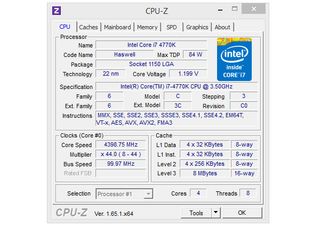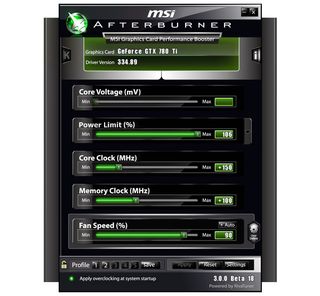System Builder Marathon, Q1 2014: Our New Enthusiast PC
System Assembly And Overclocking

Although I've seen NZXT's Phantom featured here and elsewhere a number of times, I've never actually used one in a build until today. It's a very accommodating and spacious enclosure to work in, and easy on the eyes (particularly after the bargains I'm used to rooting out for this series). I'm not a fan of the overcomplicated hard drive mounting pegs. Also, the rubber grommets that hide cable routing are too loose, and are easily dislodged during the build process. Those are minor inconveniences, though.
My build process went smoothly, and I don't really have any solid complaints to register. Everything fit nicely, and I'm bereft of horror stories to tell about fitment, scraped knuckles, or mysterious boot issues. That makes for boring reading, but it's good in the end.

Overclocking
Like most Haswell-based CPUs, this one capped out in the 4.5 GHz range. My maximum stable overclock ended up being 4.4 GHz at 1.2 V before I started running into thermal throttling. Compared to last quarter's Core i5-4670K, that's an extra 100 MHz.
Despite my high-performance memory, the system defaulted to 1333 MT/s at 9-9-9-24 1T timings, which really hurt some of the stock benchmark results. As usual, I triggered the XMP setting to hit 1866 MT/s at 9-10-9-27 2T for my overclocked results, choosing not to pursue more aggressive data rates.
The budget-oriented ASRock board stepped up to deliver the functionality expected from pricier Z87-based options. It was perfectly stable, also.

Galaxy's GeForce GTX 780 Ti was limited by its power envelope, not by stability issues. Therefore, I maintained voltage at its stock setting and dialed back my memory overclock to yield as much headroom as possible to the GPU. This helped a little in the benchmark results. I set MSI's Afterburner tool to its maximum 106% power setting, and then dialed in 150 MHz core and 100 MHz (400 MT/s) memory overclocks. The fan speed was also ramped up just to be sure thermals were limiting the performance ceiling.

Current page: System Assembly And Overclocking
Prev Page Memory, Hard Drives, And Optical Storage Next Page Test System And BenchmarksStay on the Cutting Edge
Join the experts who read Tom's Hardware for the inside track on enthusiast PC tech news — and have for over 25 years. We'll send breaking news and in-depth reviews of CPUs, GPUs, AI, maker hardware and more straight to your inbox.
-
envy14tpe Why a Galaxy GPU considering the company pulled out of US market? btw, nice work on the build.Reply -
bemused_fred I wish more builds would account for the cost of the OS. It can be a significant expense, especially when you're working with builds of $600 or less.Reply -
Dark Oopa wow, I didn't think there would be such a little difference in gaming.In fact, the difference is so small that with all the inherent problems of the SLI, the new rig is always the better choice.Reply -
redgarl Multi-gpu problems are always overly exagerated. I am using multi-gpu platforms for almost 5 years and the gain in fps over the UNOTICEABLE and overly exagerated stutering sweep away any disavantages.Folks, don't lure yourself, higher resolution demand multi-gpus. Single card is fine for anything around 1080p, more or less, but at 4K or 3 1080p monitors... your system is going to choke even with a 780 ti.Reply -
npyrhone Having 1600x900 resolution in the gaming charts serves only one purpose: to create the impression that there is not really a difference between the two builds, while in reality the later one is obviously inferior to the previous one.Reply -
vertexx It's a shame to completely remove the non-core components from the competition, but I understand why it's done here. A couple of ideas to throw out there:Reply
(1) You could include temperatures and acoustics performance in the overall assessment, given I think that is a big part of the case buying decision, and
(2) A way to factor in the intangibles (i.e. blu ray vs dvd, choice of SSD/HDD, etc), you could include a separate vote between this quarter's and last quarter's to see what the readers would choose for the best build given all the performance factors, aesthetics, and other components that do not contribute directly to performance. The reader's vote of this quarter vs. last quarter and/or an overall value winner for this quarter could be included in the final write-up.
I would also 2nd the vote for starting 4K testing. And also, why not 1440p? It seems those two resolutions are more relevant now in 2014 at the level of this competition than 1600x900 and 4800x900 resolutions. -
DarkSable I'm sorry, Tom's, but...You really need to stop misinforming the general public who comes here for your articles and doesn't read the forums in depth.You go with an i7 for the "performance benefits," which are nonexistent for gaming... except that this rig is aimed at gaming. I would have much, much rather seen an i5, with a note explaining that an i7 is a good upgrade if you're doing these sorts of things, but isn't helpful if you're building a gaming computer.There are wayyyy too many new builders out there who think that the i7 is better than the i5 and who are just wasting their money, and you aren't helping them or correcting that misinformation - rather, you're just reinforcing it further.Reply -
nekromobo I would really like to see mATX and mini-itx versions of this article, pretty please :)Reply -
vertexx Reply
Hmm.... What percentage of the performance measures in this article are for gaming?12959893 said:I'm sorry, Tom's, but...You really need to stop misinforming the general public who comes here for your articles and doesn't read the forums in depth.You go with an i7 for the "performance benefits," which are nonexistent for gaming... except that this rig is aimed at gaming. I would have much, much rather seen an i5, with a note explaining that an i7 is a good upgrade if you're doing these sorts of things, but isn't helpful if you're building a gaming computer.There are wayyyy too many new builders out there who think that the i7 is better than the i5 and who are just wasting their money, and you aren't helping them or correcting that misinformation - rather, you're just reinforcing it further.
Most Popular


